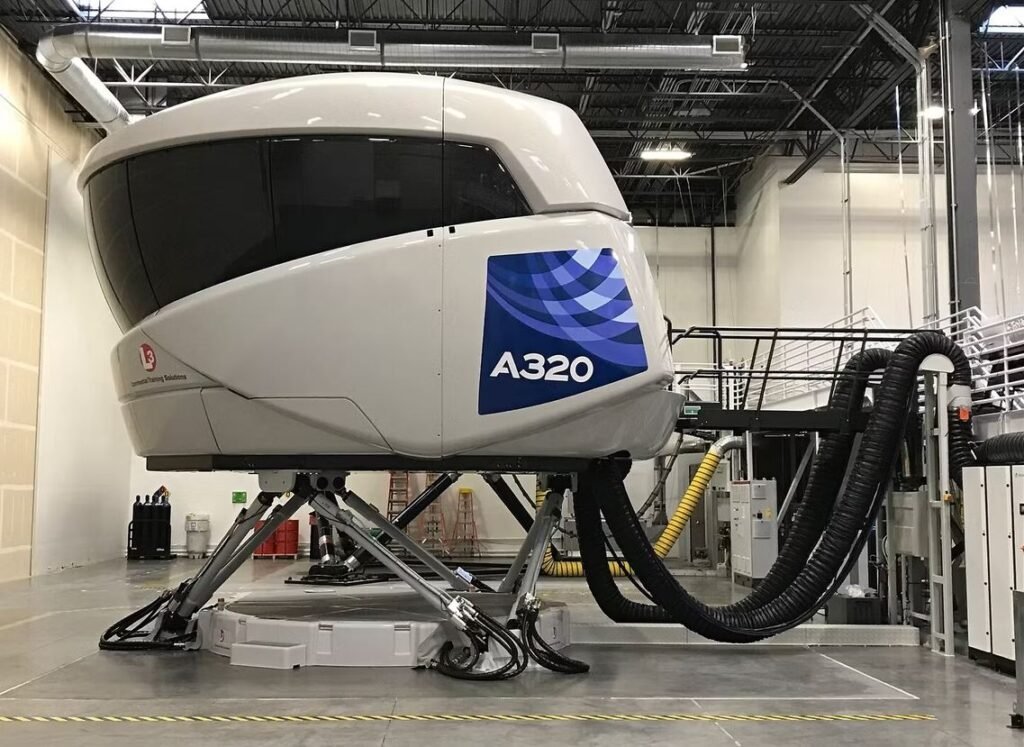stepping inside the simulator world.
In the aviation sector, flight simulators are widely utilized for pilot training and inspections. Key aviation authorities regulate their movement, eyesight, and other capabilities at four separate levels. The highest of them, Level D, represents the most advanced and precise simulators used by airlines the most frequently.

Full-flight training simulator
Full flight simulators are the premium simulators utilized by airlines. The cockpit of a particular model must be a full-size replica for it to qualify as a full flight simulator. It should have a motion system of at least three degrees and provide a full view from the flight deck.
They are strictly regulated by aviation regulators because they are a necessary component of a pilot’s training and certification process. The United States Federal Aviation Agency (FAA) and the United Kingdom Civil Aviation Authority (CAA) both use the same language and classification for full flight simulators, with four levels of increasing sophistication.
A four-level sophistication scale

The four levels of A, B, C, and D allude to a comprehensive flight simulator’s growing features and realism. The majority of airlines will select level D because it is the highest. It permits (in accordance with FAA regulations) all recurrent training and training necessary for an aircraft type rating.
So what makes the levels different from one another?
A level A simulator only has three degrees of motion in its motion system. It probably also has a fairly simple visual system.
Three degrees of freedom are also present in a level B simulator. With a higher level of fidelity aerodynamic model, it is more accurate.
Six degrees of freedom will be present in a level C simulator. Moreover, each pilot’s horizontal field of view must be at least 75 degrees.
Six degrees of freedom are also required for the highest level D simulator. With additional detail and a wider variety of lighting, visuals have substantially enhanced. Each pilot’s horizontal field of view is expanded to 150 degrees. To imitate some events, additional motion effects are required.
Still some restrictions
In terms of commercial simulator use, the level D simulator is the best there is. It will provide a wide field of vision, simulation in day, night, and dusk circumstances, and a cockpit setup and layout identical to that of the actual aircraft.
There are still apparent mobility restrictions even with the full six degrees of motion. One instance is turning on the ground. Furthermore absent are sustained acceleration and the impact of G-forces.
Try one on for size.
Of course, even the most ardent simulator enthusiast will never be able to afford a full flight simulator. But many airlines make their simulators accessible to the general public. One of the most comprehensive selections is offered by British Airlines. Sessions on the 777-200, 747-400, and 767-300 simulators can be scheduled. Costs for one hour start at £399 ($548).

Jeju Air, Thai Airlines, Emirates (who has an A380 simulator at Dubai Mall), and Eva Air are additional carriers that rent out simulators. Others are operated privately or in institutions like museums, such the one and only working Concorde simulator found at the Brooklands Museum in the UK.
Easy Flying had the opportunity to test out a full flight simulator earlier this year. Three full flight simulators are available at Icelandair’s training facility in Reykjavik, thanks to training technology giant CAE. As a result, we had the chance to mimic a Boeing 767-300ER landing.
The apparatus can change to meet the constantly shifting needs of the aviation sector. According to the CAE Icelandair Training Center:
In order to accurately depict the fleet’s system environments, cockpit configurations, and airline policies, we modify our simulators to our customers.
Simulators are essential to pilot training programs all over the world. The level D simulator has established itself as a valuable tool across the business because to its capacity to replicate real-world conditions.




